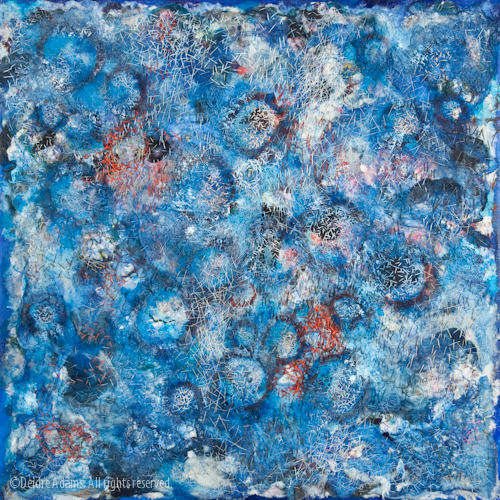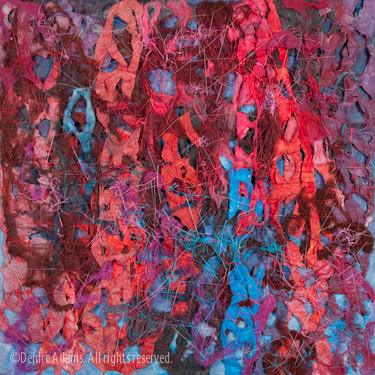Entangled II, 24 x 24 inches, ©2009 Deidre Adams
Now that school is just about over, I thought I would start posting some of the work that I’ve been doing this semester. Besides the Art Theory & Criticism class, I had two studio classes, Painting V and Printmaking II: Lithography. I’ll start with Painting.
Painting V is the last level of painting that Metro offers, and it is the time when students are expected to be hard at work developing their body of work for the all-important thesis/portfolio show. At this time, we’re expected to be pretty much self-driven, choosing what we want to work on, developing our own proposals, and being given little direction other than feedback on the proposal and the work itself, both in progress and finished. It was a stacked class, meaning that the instructor had another class to deal with simultaneously and so was stretched pretty thin trying to get around to everybody. (Not surprising with budget cuts across the board, but who knows how much worse it will get before it gets better!)
As usual, I struggled to figure out what I wanted to go with for my concept. It’s not that I don’t have any ideas, it’s just the opposite. I have too many, and I feel such affection for each of them, it’s hard to settle on a single one. I went through a couple of false starts before I finally settled on this one idea. It’s something that’s been rolling around in my mind for a long time, but I never could figure out exactly what I wanted to do with it. Part of the problem is that as a highly introverted individual, I’ve always shied away from making work that is too personal, choosing for the most part to concentrate on formal elements and/or safe choices that won’t reveal too much of myself to the world. When my mother died four years ago, someone close to me suggested to me that I should do a piece about it, to allow me to work out my feelings. No, I said, I could never do that. I wasn’t even fully capable of confronting those feelings directly; it was better to keep it all at a safe distance.
Without saying a whole lot more about it, the important thing to convey is that about 4-5 years before she died, my mother began to exhibit signs that something wasn’t quite right in her mind. She was forgetting things, losing things, saying things that made no sense, sometimes displaying irrational fears about things that no one else could see. By the time she died, she didn’t know who I was any longer, but I think from some of the things she said, she might have been confusing me with her older sister.
While I was thinking over ideas for my concept, mulling thoughts about patterns and textures in nature and science, my dad had an accident and went into the hospital. I went down to Albuquerque to see him and deal with anything that needed my assistance. While there, I stayed in my parent’s house, which always makes me think a lot about my mother. I also think about how the things I experienced growing up might have looked from her perspective, how differently those same incidents and conversations would have appeared through her eyes. I think about what she might have been like as a child and a young woman, what kind of hopes and dreams she may have had that never materialized as she continued down the path she ended up choosing.
When I got back home, something I saw, I don’t even know what now, sparked the idea of trying to tie together her experiences with the physical changes that occur in the brain of a person with Alzheimer’s disease. I did a lot of research so I could understand the science of it. Neurons, the nerve cells which transmit brain activity, die when the proteins which are normally broken down and eliminated by the body instead become reformed into hard, insoluble plaques. Microtubules, the brain’s cellular transport system, break down abnormally and the proteins released reform into insoluble twisted fibers called tangles. As these cells die, the brain shrinks. Ventricles, the chambers containing cerebrospinal fluid, become enlarged.
Having seen the outward manifestations of these changes, I visualize the thoughts inside the person’s head becoming trapped: twisted, tangled, and cut off from their normal pathways by these cells and obstructing formations. An idea tries to make its way to a familiar connecting point, but it’s either stopped completely or diverted to a place it’s not supposed to go.
I wanted to use fibers and thread to express my concept, both because I love using them and because these materials seemed like a natural fit to express the concept of entanglement. As more and more thread is added, the surface becomes at once more complex and more unified. The idea is not a literal representation of brain cells, but rather a depiction of how the strangulation of the sending and receiving cells means they can no longer function as they should.
Entangled I, 24 x 24 inches, ©2009 Deidre Adams
These originally started out as strictly fiber works, but the shapes were very wonky and I couldn’t figure out how I would hang them. I also knew I would need several more pieces in the series, especially since these two were so different. I would need to make more pieces with bridging elements to make everything work together as a single exhibit. So I came up with the idea of making a grid of 24-inch squares, and to that end I ended up stitching these pieces to stretched canvas.
I also started a third piece, but since these are extremely time-consuming, I didn’t get this one to a satisfactory state before the due date. I’m not even sure if I want to keep going with it. For now, it’s a UFO (unfinished object).




I think these are brilliant – I’d love to see the texture for real. You’re taking real risks and departures from what you’ve done in the past. To me the best art is that which is informed by personal experience and emotion but doesn’t attempt to make it too literal or personal — exploring the concept in a way that is both inclusive and restrained, so the viewer has a chance to develop some intimacy with it. Does that make sense?
Deidre, Thanks for sharing your work online. I was touched by the story of your mother’s dementia and Alzheimer’s condition. I found your work quite depictive of this conditon. It is so sad that Alzheimer’s cannot be diagnosed until the victim is deceased. However, lets hope that changes and a cure is also found.
As a fellow artist, I would not expect something depicting such a horrible disease to be “pretty.” I did find “Entangled II” to be curious and almost drawing me into the web. “Entangled I” seems to be over whelming with the lines and I am not sure if I like the white. It is such a dark, misunderstood and frightening subject. But as usual, I find your work intriguing and love the abstraction of it. June 🙂
Lainie, that makes perfect sense, and it’s exactly what I’m attempting to do. I like art that lets you draw your own conclusions, so that’s what I try to offer as well. I hope that comes through.
June, you’re right that no. II does get pretty overwhelming. I was feeling very emotional while I worked on these, and maybe that one got a little frenetic. I had wanted to add even more thread than what is on there now, but everyone said it was enough so I stopped. Thank you so much for commenting!
Deidre
As I am the caretaker for my mother who has dementia I live with the effects of it all the time. Perfect description of the condition. My mother knows something isn’t right and it frustrates her tremendously. She gets snippets out but travels back and forth between being with it and hallucinating. My quilt For the Saintly Mother whose Crown has Slipped is an homage to her current state.
Mary Ann
Mary Ann, your work is absolutely beautiful; thoughtful and graceful. I wish you strength throughout this difficult time. Thank you for commenting, and I hope you will keep me updated on how it goes.